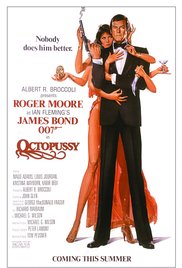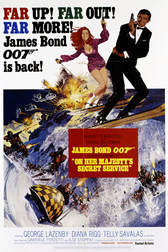|
Predictably, in the James Bond movie entitled Octopussy (1983) women are highly sexualized, but what is also disturbing is the violence against women (VAW) perpetrated by men. Moreover, it starts during the opening credits: two naked women are shot. In the first instance the woman is holding the gun and a red laser beam shoots out of it at her vagina. In the second instance a man holds the gun, which appears close to her chin, and when he shoots at her the following words emerge from his gun: Produced by Albert R. Broccoli. Later James Bond (Roger Moore) forces himself on a woman named Octopussy (Maud Adams). She is also abducted, knocked unconscious, shoved down against a plane seat and struck across the face. The movie poster presents an accurate picture of what story writer Ian Flemming, producer Albert R. Broccoli and director John Glen have in store for viewers: a barelegged woman in high heels stands behind a fully dressed man in flat shoes, and the tagline reads: Nobody does him better. Her eight arms undress him, caress his hair and his gun, hold a martini, fiddle with his bow tie, etc. This 13th Bond movie made US$187.5 million at the worldwide box office. It is telling about our societies that the movie made so much, and that the filmmakers were consequently permitted to make more movies.
© 2017 Alline Cormier
0 Comments
Yesterday was National Aboriginal Day. For my part it provided another opportunity to reflect a little on the fate of one of my fellow Canadians, Helen Betty Osborne. She was only 19 years old when she was abducted off the streets of The Pas, Manitoba, on November 13, 1971, by four men: Dwayne Archie Johnston, James Robert Paul Houghton, Lee Scott Colgan and Norman Bernard Manger. They sexually assaulted her and stabbed her with a screwdriver over 50 times before leaving her in the bush outside The Pas. Yet it wasn't until 1987 that Dwayne Johnston was convicted of second-degree murder and sentenced to life imprisonment. He was then released after serving 10 years of that sentence. James Houghton was acquitted. Lee Colgan received immunity from prosecution in return for testifying against Houghton and Johnston. He was never punished. Norman Manger was never charged. Osborne was Native, meaning that she was doubly discriminated against: once for being a woman and again for being Aboriginal.
I'm glad we have a National Aboriginal Day in Canada, and I hope that some day it will be a national holiday. It certainly means a lot more to me than Easter and Victoria Day. And the more we honour and respect Natives in this country the fewer deaths like Helen Betty's there should be. © 2017 Alline Cormier Last night I saw Wonder Woman at the theatre with my husband and sons. Given that this is a Hollywood movie my expectations weren't high, but director Patty Jenkins must have been the right choice because this movie provides audiences with one of Hollywood's exceptionally rare positive portrayals of women. For starters, the lead female role, the goddess Diana, is far less sexualized than the vast majority of women in mainstream movies--I don't remember a single bath/shower scene. But it's more than that. She differs from them in several ways, namely: the attempts made to silence her do not deter her from continuing to make her voice heard; she is not shown drinking alcohol, getting loose and partying; she is not portrayed as superficial and materialistic; she is capable of interacting with men without flirting; she has positive interactions with other women; she criticizes uncomfortable clothing that restricts women's movements; her presence is not limited to being eye candy for men; her role is not limited to falling in love with a man (and ending up in his arms in the last scene), etc.
If I had a girl this is one of the only Hollywood movies I would let her see because not only is it one of the rare movies in which women are not men's playthings but also because the female lead is strong, capable, powerful, altruistic and concerned about the state of the world--unlike the near totality of female roles that have come out of Hollywood. This Diana is an anomaly in Hollywood, which is a shame because her character is a very realistic portrayal of women, other than her physical superpowers, obviously. I'm happy my teenage boys saw this movie. Now they have this positive cinematic portrayal of womanhood stored in their mind that they can compare with the other, more negative ones, they are continually exposed to. © 2017 Alline Cormier The more movies I analyse from the 1960s the happier I am about not being born yet when they were made. The '60s looked particularly awful for women. The last Bond movie from that decade is On Her Majesty's Secret Service (1969). Diana Rigg plays the female lead, and a lot of violence is perpetrated against her: in the opening scene a man holds a knife to her throat before grabbing her by the back of the neck and pushing her away; Bond strikes her; another man chokes her; her father punches her (rendering her unconscious); and finally she is shot dead--and that's just the physical violence.
Having already analysed roughly a dozen Bond movies I had come to expect this abusive treatment of women, but I was taken aback by the language used to encourage men's dominance over women. For instance, Rigg's father says to Bond, whom he is encouraging to marry his daughter: "What she needs is a man to dominate her, to make love to her enough to make her love him!" Later, when she marries Bond, her father says to her, "Remember, obey your husband in all things. You promise me?" This movie made US$82 million at the worldwide box office, so it's fair to say it had a pretty wide reach. The messages conveyed in it were assimilated by baby boomers--my parents' generation. The damage it did—not to mention the other Bond movies--is likely incalculable, but I'm taking a stab at it in my upcoming book on the sexualization of women in media. © 2017 Alline Cormier #Bond #JamesBond #OnHerMajestysSecretService |
Categories |




 RSS Feed
RSS Feed